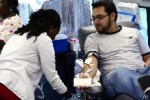Blood and tears

It can be tough for people to overcome their fears. However, when an opportunity arises to save lives, it’s time to be brave. In my case, I had to overcome my fear of needles to donate blood for the first time.
I know people who have given blood and I’ve seen the colored tape around their arms, but I never thought about what goes into the process of losing a bit of yourself for a good cause.
Each year the Florida Blood Services (FBS) bloodmobiles travel more than 250,000 miles across Hillsborough, Manatee, Pasco and Pinellas counties to ensure that blood needs are met, according to fbsblood.org. The bloodmobiles visit USF twice a week, arriving on campus every Tuesday and Wednesday.
After deciding to give blood, my first step wasn’t to walk onto the bus but to prepare myself by eating breakfast.
“I’ve had high school students come on the bus and say they had some candy or a bite from their friend’s breakfast biscuit,” Maria Lysiak, head of the blood services bloodmobile said. “That’s not breakfast.”
FBS recommends eating a meal high in iron, such as a bowl of cereal or leafy greens.
Once on the bus, I began my journey to donate blood by providing the staff with my ID and general information, which was used to assign me a donation number that I could later use to call the FBS Healthline to find out my blood type and cholesterol levels.
While waiting to go into a private booth to answer about 50 more questions about my health, I talked to other students who were already donating blood. Many of them had given blood before and make it part of their regular schedules.
One such student was Jonathan Fernandez, a senior majoring in Education and Religious Studies. He sat at the end of the bus hooked up to the ALYX machine, which separates blood into three basic components – plasma, platelets and red blood cells. By using ALYX, FBS can retain more red blood cells while returning the remaining components back into the donor.
It was Fernandez’s second time being connected to ALYX.
“For me, it’s part of my religious beliefs. It’s a way to impact other’s lives,” he said.
Since ALYX obtains more red blood cells, it takes 25 to 30 minutes to separate the blood, as opposed to the normal 8 to 15 minutes for normal donations. ALYX donors must also wait four months before returning to donate blood, versus the eight-week waiting period for normal donors.
With the positive attitudes from other students, I thought I was ready. I felt calm and almost excited. My fear of needles was behind me.
“It’s the people who are afraid that faint,” Lysiak said.
I leaned back onto the soft chair and ate a free cookie. Next to my arm, Donor System Specialist Adeline Bleau set up the primary blood bag, along with the four small tubes FBS uses for testing. I felt calm as she pulled out an alcohol-saturated cotton swab and began to clean my arm for 30 seconds. Then things changed.
“Are you ready?” Bleau asked.
I answered with a weak, “Yes.”
The question made me realize I wasn’t there just to ask questions but to participate. I became nervous, but it was too late. Bleau readied the needle and began to insert it into my arm.
There was no pain, but the feeling of having the needle in my arm whenever I clenched my fist made me nervous.
Alesia Williams, another staff member on the bus, saw my anxiety and tried to calm me down by making jokes. She made me feel better but I still forgot to do one important thing: breathe.
Even while sitting down I could feel myself becoming light-headed. Williams and the rest of the staff laughed as they comforted me with an extra cookie and some soda.
After the needle was out and the staff had bandaged my arm, I felt better. I had a sense of accomplishment.
I happened to look over my shoulder and saw the blood bag and test tubes filled with what I found out to be O positive blood.
“So that’s my blood?” I asked.
“It’s not your blood anymore. It’s mine now,” said Williams.





